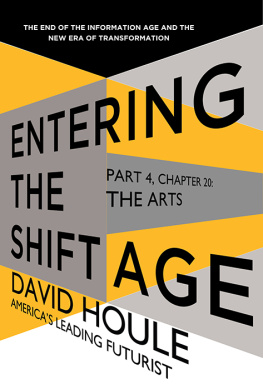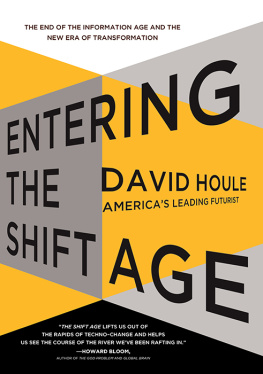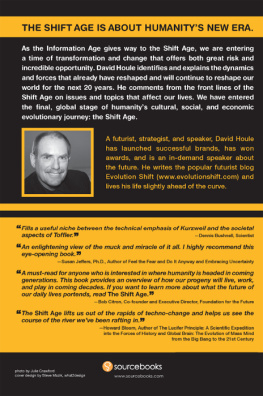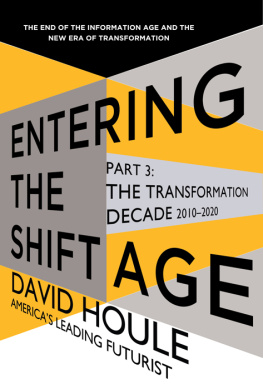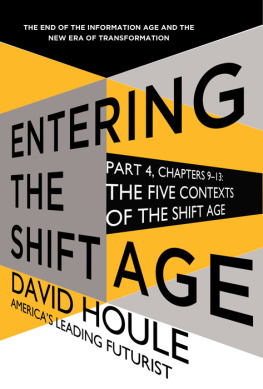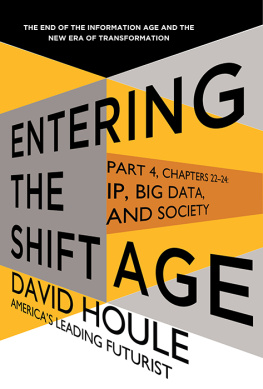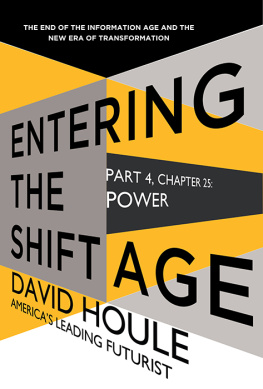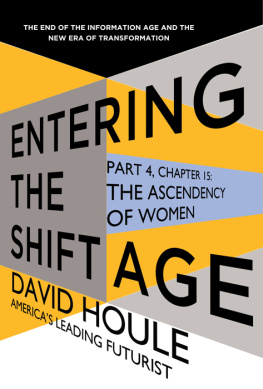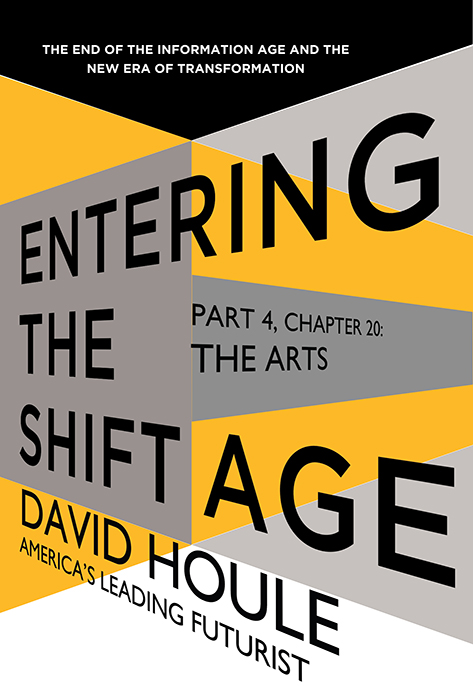
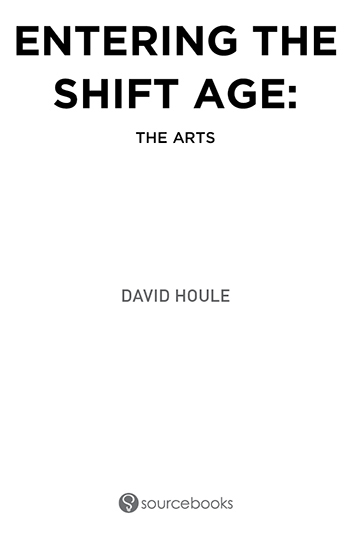
Copyright 2012 by David Houle
Cover and internal design 2012 by Sourcebooks, Inc.
Cover design by Studio Gearbox
Sourcebooks and the colophon are registered trademarks of Sourcebooks, Inc.
All rights reserved. No part of this book may be reproduced in any form or by any electronic or mechanical means including information storage and retrieval systemsexcept in the case of brief quotations embodied in critical articles or reviewswithout permission in writing from its publisher, Sourcebooks, Inc.
This publication is designed to provide accurate and authoritative information in regard to the subject matter covered. It is sold with the understanding that the publisher is not engaged in rendering legal, accounting, or other professional service. If legal advice or other expert assistance is required, the services of a competent professional person should be sought. From a Declaration of Principles Jointly Adopted by a Committee of the American Bar Association and a Committee of Publishers and Associations
All brand names and product names used in this book are trademarks, registered trademarks, or trade names of their respective holders. Sourcebooks, Inc., is not associated with any product or vendor in this book.
Published by Sourcebooks, Inc.
P.O. Box 4410, Naperville, Illinois 60567-4410
(630) 961-3900
Fax: (630) 961-2168
www.sourcebooks.com
CONTENTS
PART 4
THE FUTURE
OF HUMANITY
In Part Four, we will look at the future by first focusing on some large concepts and contexts of the Shift Age, followed by a close look at particular segments of society and humanity.
In Part Two, we looked at the three dominant forces of the Shift Age: The Flow to Global, The Flow to the Individual, and Accelerating Electronic Connectedness. These three forces are driving several big ideas that are initiating massive change now, and will have largely reshaped our world by the year 2025.
One clear difference between the Information Age and the Shift Age is content and context. The true clich of the Information Age was content is king. The reality of the Shift Age is context is king. Entering the Shift Age, we live in an increasingly contextual world. I have selected the five contexts I think have the greatest impact and influence.
THE FIVE MAJOR UNDERLYING CONTEXTS OF THE SHIFT AGE
1.The Earth Century
2.The need to retrofit the twentieth century
3.The Concept of Place has changed forever
4.The merging of biology and technology
5.The move toward an evolutionary shift in human consciousness
So now let us begin by taking a look at these five contexts, and then explore what much of society will look like in the years and decades ahead. Some of the areas we will explore the future about are Shift Age Generations, Education, Technology, Energy, Brands and Marketing, the future of the Nation-State and Powerall areas that will have transformational change.
Its time to enter the Shift Age and our collective future.
CHAPTER TWENTY
THE ARTS
Art, artists, and the arts express the beauty and often the essence of a society, culture, or civilization. In fact, artists are often suggesting where the society or culture is going. The old line about life imitating art certainly applies.
In the last 125 years, art has certainly done this, whether it was the futurist art movement or the cubists in pre-World War I Europe giving us an early look into the speed and fragmented aspects of twentieth-century life, or the pop art in the early 1960s that was a precursor to the brand-oriented pop culture of the latter part of the twentieth century.
Music and theater have always been of their time as well, reflecting the sound and drama of current society. From the dissonance of jazz in post-World War II time to the electrified rock and roll of the 1960s to todays electronic dance music, all speak of their respective times. Music comes into being as an expression of its time and then becomes preserved, as does visual art, in cultural institutions that honor the great works of the past.
It is as though art in all forms leads the way and then, embraced by the culture, it moves into its institutional honor and preservation phase.
So art is an early signpost of the direction of a culture. Then, when embraced, it becomes of the culture, and finally the culture institutionalizes it and a new wave begins.
So art is before its time when it first enters society, of its time when society embraces it, and honored and preserved by society when its time is past.
So what is the future of the arts in the Shift Age?
A Look Back
As Futurist in Residence and adjunct professor at the Ringling College of Art + Design, I created and taught a senior-level course for the Business of Art and Design major in the fall of 2011 called The Future of Creativity in the Arts. The fourteen students in this course were some of the brightest and most creative young people I have ever met. Their charge was to see what creativity and the arts would look like in the years ahead. The process I went through with these members of a Shift Age generation helped to shape this chapter.
The first significant step to determine the future of creativity was to take a look back at the history of creativity in the arts from 1200 to 2010 with an emphasis on artistic breakthroughs. Across about 18 feet of white board, we charted that history left to right, dividing it into three sections. The first spanned the years 12001800, the second was 18002000, and the third was 20002030. The vertical axis of the whiteboard represented the significance of the breakthrough on creativity in the arts. So if the breakthrough was of great influence it was placed high up; less so, lower down.
Then, in green we put down artistic innovations, and in red, scientific discoveries, technological inventions, or innovations. An example of green was Giottos bringing perspective to painting for the first time in the 1200s or Dutch painting creating art for the middle class in the 1600s. An example of red was Gutenbergs inventing the movable-type press in 1454 or the invention of photography in the mid-nineteenth century.
The first thing to report was that there was more green than red in the first section, from 1200 to 1800. In the second section, there was the same amount of both up to 1900. Then from 1900 to 2000 and from 2000 to 2030, red was in clear domination.
The obvious conclusion was that, particularly in the last 100 years, technological innovation and scientific inventions have had a greater effect on creativity in the arts than anything coming from the arts themselves.
The second thing to mention was that the section for the two hundred years, 18002000, had at least twice as many red and green entries as the six hundred years, 12001800. The section 20002030 had as much as the 12001800 section did. This points out the acceleration of innovation and change even in the arts in the last few centuries. This of course reflects the acceleration occurring in many areas of society.
A Look Ahead
So at the end of the semester, we put together a dynamic presentation on the future of creativity in the arts. It is a presentation that has already proved to be prophetic and which I still think is the best forecast on the subject I have seen. Here were the general conclusions:
Writers will have ever more direct connection to the reader/consumer, and vertical writing comparatives will occur along the lines of what Pandora does now for radio, providing customized recommendations of authors or books.

